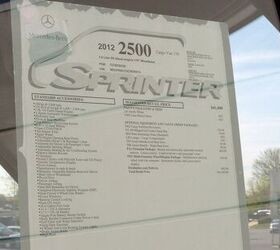The Mercedes-Benz Sprinter introduced a fresh perspective to the American cargo van market when it first arrived under the Dodge banner. Representing the European van philosophy, the Sprinter differed significantly from traditional American vans. As competitors like Ford and Ram followed suit with their European-inspired designs, and with only GM and Nissan holding onto the classic American van style, the Sprinter’s impact became undeniable. We got our hands on a 2012 Mercedes-Benz Sprinter 2500 to delve into what makes this van a standout choice for businesses and professionals.
European Design: A Step Above Traditional Vans
The European van concept, exemplified by the 2012 Mercedes-Benz Sprinter 2500, brings several key advantages, starting with the driver’s environment. The high seating position immediately provides excellent visibility through the expansive windshield, creating a commanding feel behind the wheel. While the engine does intrude into the cabin, it’s far less obtrusive than in typical GM vans, offering ample legroom. Unlike some competitors with bulky consoles, the Sprinter’s design keeps the floor space clear from the knees back, enhancing movement within the cabin.
The seats in the 2012 Mercedes-Benz Sprinter 2500 are distinctly firmer and more supportive than those found in many other vans. Reflecting a German design ethos, they prioritize ergonomics, suggesting better long-term comfort and back support, particularly beneficial for drivers spending extended periods on the road. Optional packages offer further customization with front and rear height adjustments, recline, and lumbar support, all manually operated for reliability and reduced maintenance.
Unmatched Cargo Space and Versatility
Mercedes-Benz offered the 2012 Sprinter 2500 in a variety of configurations to suit diverse needs: 144-inch wheelbase with a regular roof, 144-inch wheelbase with a high roof, 170-inch wheelbase with a high roof, and an extended length 170-inch wheelbase high roof for cargo van models. Even the standard roof height of the 2012 Mercedes-Benz Sprinter 2500 surpasses GM vans, offering 60.6 inches versus 52.9 inches of interior height. The high roof option elevates this further, providing over a foot of additional headroom, allowing individuals up to six feet tall to comfortably stand and work inside – a significant advantage for tradespeople and mobile professionals. Nissan is a rare competitor offering a similar factory high-roof option.
The rear cargo door opening of the 2012 Mercedes-Benz Sprinter 2500 is also notably wider at 61.6 inches compared to 57.0 inches in GM vans. This width is consistently maintained from floor to ceiling due to the van’s almost vertical side walls – a design contrasting sharply with the more rounded, “jelly bean” shapes of traditional American vans. Cargo lengths range from 128.5 inches to an expansive 185.0 inches depending on the chosen body length, significantly outperforming the 124.6 inches to 146.2 inches offered by GM vans. In terms of cubic cargo volume, the 2012 Mercedes-Benz Sprinter 2500 dominates, offering 318, 494, or a massive 547 cubic feet, easily exceeding the 270 or 314 cubic feet of GM vans. Even the shortest, standard roof Sprinter provides more cargo capacity than the longest GM van and double the space of a typical minivan.
Accessibility to this substantial cargo volume is excellent, with wide, floor-to-ceiling door openings. A right-side sliding door comes standard, and a left-side slider is optional for the 2012 Mercedes-Benz Sprinter 2500. The rear doors offer a 270-degree opening capability, further enhancing loading and unloading convenience. The Sprinter 3500 model boasts a payload capacity of up to 5,375 pounds and a towing capacity of 7,500 pounds, surpassing the GM van’s 3,992 and 10,000 pounds respectively. The 2012 Sprinter 2500 model we tested had a payload of 2,872 pounds, slightly less than the GM 2500 van’s 3,009 pounds.
Passenger configurations for the 2012 Mercedes-Benz Sprinter 2500 range from two to twelve occupants, accommodating one to four rows of seats. Even with four rows installed in the 170-inch wheelbase model, over six feet of cargo space remains. While Mercedes-Benz opted out of the 15-passenger van market segment, focusing instead on robust functionality and cargo space, passenger comfort is addressed with factory roof-mounted rear HVAC vents, although luxury is not the primary focus of this commercial vehicle.
Efficient Diesel Power and Performance
Despite its impressive cargo and towing capabilities, the 2012 Mercedes-Benz Sprinter 2500 is powered by a surprisingly compact and efficient engine. The sole engine option is a 3.0-liter turbocharged diesel V6, producing 188 horsepower at 3,800 rpm and 325 pound-feet of torque at a low 1,400 rpm. This is significantly smaller and less powerful than the V8 engines commonly offered by American competitors like GM, Ford, and Nissan. The 2012 Sprinter 2500 is paired with Mercedes-Benz’s reliable five-speed automatic transmission.
While initial impressions might raise concerns about power, real-world performance is surprisingly adequate. During our test drive, the powertrain provided more than sufficient acceleration for a vehicle of this type, even at highway speeds around 80 mph. An estimated zero-to-sixty mph time of around 13 seconds might seem slow compared to modern cars, but it’s perfectly acceptable for a large cargo van. The diesel engine delivers its torque effectively, making the 2012 Mercedes-Benz Sprinter 2500 feel responsive in typical driving conditions. While we didn’t test it under maximum load, user feedback suggests that engine performance remains satisfactory even when heavily loaded. Braking performance under load, however, could be a more critical consideration.
The diesel engine noise is minimal, particularly when cruising or under acceleration. The transmission operates smoothly, though quicker gear changes could be desired in certain situations. Notably, paddle shifters are not offered as an option on the 2012 Mercedes-Benz Sprinter 2500.
Fuel Efficiency: A Major Advantage
Fuel economy is a standout feature of the 2012 Mercedes-Benz Sprinter 2500. Mercedes-Benz specialists claim fuel economy figures in the low 20s mpg for city driving and mid-20s mpg on the highway. Considering the size and 5,545-pound curb weight of the vehicle, these figures are impressive. In our mixed suburban and highway driving loop, the trip computer indicated 17.6 mpg, which is notably better than many larger SUVs and minivans in similar conditions. The 2012 Sprinter 2500 does require AdBlue, a diesel exhaust fluid, but it is now readily available and reasonably priced, mitigating previous concerns about accessibility and cost.
Handling and Ride: Surprisingly Nimble
Driving a large van for the first time can be daunting, but the 2012 Mercedes-Benz Sprinter 2500 offers a surprisingly manageable driving experience. The forward visibility is exceptional, especially compared to competitors like Nissan. The expansive windshield minimizes the sense of driving a large vehicle. Rear visibility depends on the configuration – cargo vans may lack rear windows behind the first row, but large, dual-element side mirrors compensate effectively. Optional front and rear obstacle detection systems further aid maneuvering in tight spaces.
The steering of the 2012 Mercedes-Benz Sprinter 2500 is light and slow, typical for vehicles in this class, but it feels intuitive after a short adjustment period. Body control is tighter than in many traditional vans, contributing to a more confident driving feel. The ride quality in the 2500 model is slightly jiggly when unladen, but still acceptable for a commercial vehicle. Compared to a Nissan NV 3500, the Sprinter 2500 offers a more refined ride, although direct comparisons between 2500 and 3500 models might not be entirely fair. Standard stability control enhances safety, though we did not push the 2012 Mercedes-Benz Sprinter 2500 to its limits to test its operation.
Pricing and Market Position
The 2012 Mercedes-Benz Sprinter 2500 started at $37,285 for the 144-inch wheelbase and $42,395 for the 170-inch wheelbase. The high roof option added approximately $2,670, while the extended wheelbase and extended rear overhang added further to the price. Essential features like seat adjustments, power mirrors, cruise control, and a trip computer added around $895. While seemingly affordable for a Mercedes-Benz, the Sprinter is more expensive than basic American cargo vans. For example, a Chevrolet Express 2500 extended length van with a 280-horsepower 4.8-liter gas V8 and similar features was priced around $31,740. However, opting for the 6.6-liter Duramax diesel in the GM van largely eliminates the price advantage.
The 2012 Mercedes-Benz Sprinter 2500 occupies a unique market position. Until Ford and Ram introduced their European-sourced vans, the Sprinter stood alone, offering a combination of high roof availability, exceptional cargo volume, refined suspension, and a fuel-efficient diesel engine. Beyond practical advantages, the Mercedes-Benz badge carries prestige, which can be valuable for businesses that visit clients in upscale locations. Even for businesses focused on more utilitarian services, the Sprinter offers a level of sophistication and efficiency unmatched by traditional American vans.
Conclusion: A Top Choice for European-Style Cargo Vans
The 2012 Mercedes-Benz Sprinter 2500 presents a compelling package for businesses seeking a versatile, spacious, and efficient cargo van. Its European design philosophy translates to significant advantages in cargo capacity, interior ergonomics, and fuel economy. While the initial price might be higher than basic American vans, the Sprinter offers a level of refinement, capability, and brand prestige that justifies the investment for many users. For those prioritizing space, efficiency, and a more sophisticated driving experience in a cargo van, the 2012 Mercedes-Benz Sprinter 2500 remains an excellent choice.

